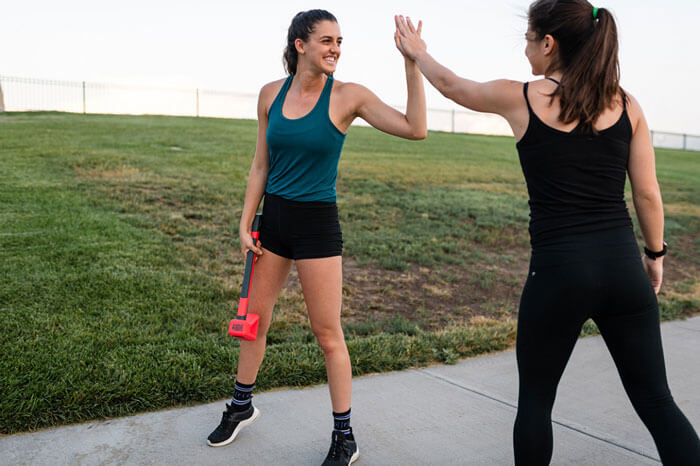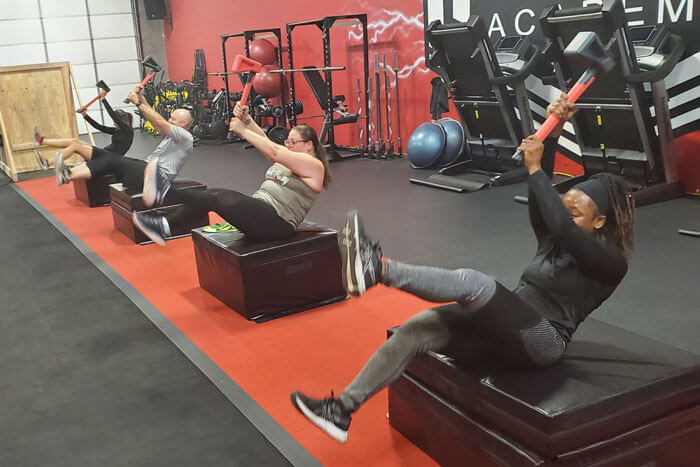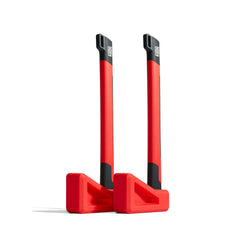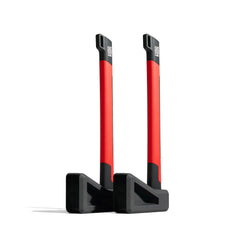The way we approach exercise and fitness has changed forever. But what will happen once the pandemic ends?
When gyms and other training facilities locked down in March 2020, people made pivots to new types of workouts in the comfort of their home. YouTube circuits, Zoom sessions with trainers and a never ending delay in Peloton orders became the new normal. Dumbbells and resistance bands disappeared from both in-store and e-commerce shelves. Folks were desperate to keep up some kind of routine.
For some, those new routines have stuck. Others have started to return to gyms and in person classes as normal.
According to Bloomberg, “At the peak of gym closures last March [2020], McCarter said class bookings everywhere fell as much as 85%. In the U.S., the return to in-person studio classes has been uneven, thanks in part to varying state and local restrictions. In New York and California for example, bookings were roughly 50% of 2019 numbers, whereas in states such as Arizona and Georgia they were down only 15%”
But the world has changed. Though we’re getting vaccinated en masse and returning to a semblance of new normal, there’s a fresh consensus on how we look at fitness, what we define as exercise, and how we can adapt our routine to our surroundings given the right information and equipment. Consumer interest in all things home-based (including cooking, interior design, and, of course, exercise) peaked mid-pandemic. It’s not going anywhere anytime soon.

Here’s what you can expect from the fitness industry post-COVID:
Fitness in a Post-COVID World
Exercise will continue to be mobile.
For many, remote work will continue to be a reality as companies continue to shutter physical offices. Plus, with more folks getting vaccinated every day, travel will continue to open up across the country and eventually, internationally. Many will continue to keep up at-home routines using products they have to curate a workout that doesn’t require them to find a gym or training facility out of the way.
Equipment that is portable, like our Chopper, that can be used both at home and on-the-go, will continue to increase in prominence for a mobile society.
Community is more important than ever.
Community has always been integral to fitness. Whether you attend a boutique workout class, participate in a team sport, or exercise one-on-one with a personal trainer, having support from others is proven to be a significant motivator.

In fact, a study conducted by Frontiers in Psychology showed the effect of a lack of community on exercise motivation during the pandemic in 22 participants. One stated:
“Almost all gone, ………….the motivation is the most ruined thing today, ……….talking about my workout, I have been hitting the gym since I was 22………, Imagine how much that space motivated me, I miss that, my pals there……., not because we are friends or something, see gym doesn’t provide you an environment to make pals or something as people change their gyms and many a thing but, they give you a lot of competition, you become jealous of their appearance and later that workout that space becomes your habit, I miss that, say like anything, but still I am trying.”
But if Zoom hangouts and virtual gatherings have taught us anything, community can be fostered online, too. That same study saw participants who used social media as a support system 35% more likely to adhere to a physical exercise program.
Community is what you make of it, and it can be found both online and off. What that support looks like depends person to person.
Gyms aren’t going anywhere, but they’re changing.
There’s something to be said for having a one-stop shop for your fitness and nutrition needs. That’s what gyms will need to be in order to compete. But they’ll also need to exceed customer expectations and provide new and unique experiences.
“The pandemic won’t kill traditional gyms, but it will cripple them, says Barr [for Men’s Health]. In the summer of 2020, he commissioned an outside research firm to conduct a poll of over 1,000 Americans who had spent at least $500 or more on fitness in the last year. The percent of those people working out at home each week jumped from 43 percent before the pandemic to 73 percent during the pandemic. About 25 of those gym goers said they won’t be going back to gyms.”
In the same way we’ll likely balance working from home and the office, folks will appreciate exercising in a gym — to achieve that community aspect — and from home, for a more convenient and time-sensitive sweat. Fitness equipment brands that can build a following both in the at-home market and in the gym will rule the day.

Wearable tech is a must-have (for many).
Post-COVID, many are likely to remain both working and working out from home. The ability to track progress is important for any fitness program, no matter what it looks like. For that, wearable tech is a must.
Connected devices and smart watches are nothing new, but they are evolving and helping us to stay on top of our fitness goals. They’re especially important if you’re going to continue working out from home or if you want to compete with others around the globe.
Workout routines will require diversity.
Gyms may have the shiny equipment and fancy machines, but you’re limited to those four walls. Boutique classes are fun and flashy, but they have to work with your schedule. All that to say, traditional fitness venues make workouts accessible and attainable, but they don’t always make them interesting. This is especially true if you’re doing the same thing day in, day out.
That’s where balance comes in.
Cedric Bryant, president of the American Council on Exercise, told TIME Magazine that “people are going to return to the gym, but people will also look to mix in some of the old-school experiences,” Bryant predicts. “It won’t be so compartmentalized–[it’ll feel more like] ‘I’m just going out and doing what is naturally available to me.'” When the world reopens, we may find that our gym can be anywhere.”
Diversity breeds motivation when you’re not stuck in the same routine every day. If one good thing will come from fitness after COVID, it’s the ability to break a sweat wherever you are with whatever you have to work with.
With the new normal in mind, determine what you need most from your fitness routine
Whether you crave the flexibility of at-home fitness, or are you itching to return to group classes, fitness after COVID looks different for everyone. It’s important that you feel comfortable in whatever routine you choose and that you set yourself up for success. Establish goals, create sustainable habits and track your progress along the way. Regardless of the path or the venue you choose, it’s important to stay active and keep moving.






